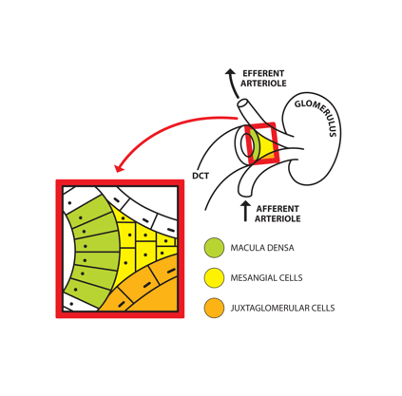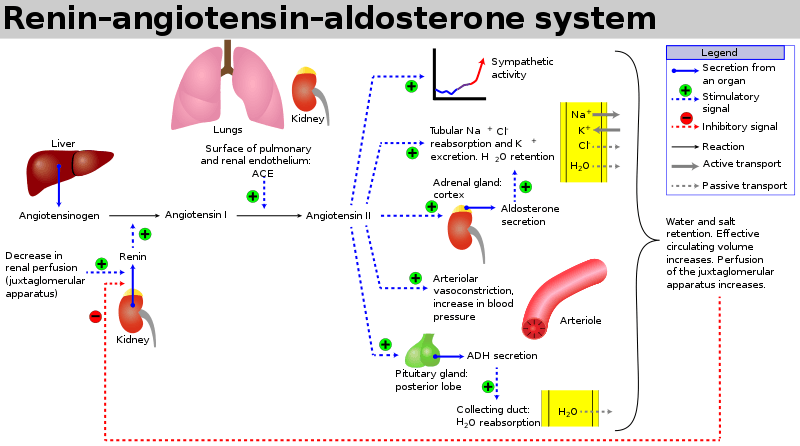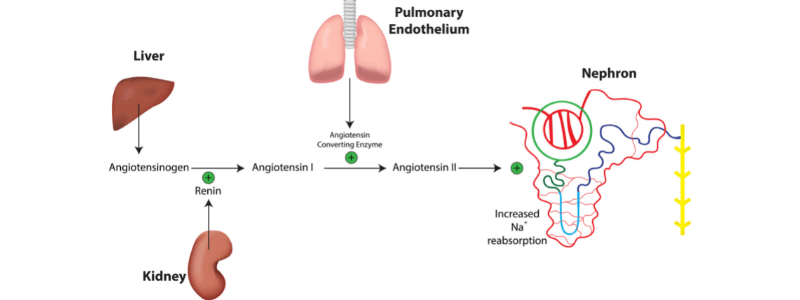The renin-angiotensin-aldosterone system (RAAS) is a hormonal system that is responsible for the regulation of arterial blood pressure and of the concentration of sodium in the plasma.
Renin and angiotensinogen
The first stage of the RAAS is the release of the enzyme renin. It is released from juxtaglomerular cells that are situated in the afferent arterioles of the kidney in response to the following stimuli:
- Decreased arterial blood pressure (reduced renal perfusion)
- Decreased sodium load delivered to the distal tubule of the kidney
- Sympathetic nervous system stimulation
Angiotensinogen is an alpha-2-globulin that is produced and released into the circulation primarily by the liver. Plasma angiotensinogen levels are increased by:
- Increased corticosteroid levels
- Increased thyroid hormone levels
- Increased oestrogen levels
- Increased angiotensin II levels
The main action of renin is to cleave the peptide bond between the leucine and valine residues on angiotensinogen, converting it to angiotensin I. This activates the RAAS and eventually causes an increase in mean arterial blood pressure and restoration of renal perfusion.
The release of renin is inhibited by atrial natriuretic peptide (ANP), which is released by stretched atria in response to increases in blood pressure.

The juxtaglomerular apparatus © Medical Exam Prep
Angiotensin II
Angiotensin I is then converted to angiotensin II by the removal of two C-terminal residues by the enzyme angiotensin-converting enzyme (ACE). This primarily occurs in the lungs, although it does also occur to a lesser degree in endothelial cells and renal epithelial cells. Angiotensin II is the main bioactive product of the RAAS.
The main actions of angiotensin II are:
- Vasoconstriction of vascular smooth muscle (resulting in increased blood pressure)
- Vasoconstriction of the efferent arteriole of the glomerulus (resulting in an increased filtration fraction and preserved glomerular filtration rate)
- Stimulation of aldosterone release from the zona glomerulosa of the adrenal cortex
- Stimulation of anti-diuretic hormone (vasopressin) release from the posterior pituitary
- Stimulation of thirst via the hypothalamus
- Acts on the Na+/H+ exchanger in the proximal tubule of the kidney to stimulate Na+ reabsorption and H+excretion
Angiotensin II will, therefore, have the following effects on renal measurements:
- Decreased renal plasma flow
- Increased filtration fraction
- Increased glomerular filtration rate
Aldosterone
The final step in the RAAS pathway is the release of aldosterone. Aldosterone is a steroid hormone produced in the zona glomerulosa of the adrenal cortex. Angiotensin II acts on the adrenal cortex to stimulate its release. It is the main mineralocorticoid hormone and plays a central role in the regulation of blood pressure.
Aldosterone is released in response to:
- Increased angiotensin II levels
- Increased potassium levels
- Increased ACTH levels
The main actions of aldosterone are:
- Reabsorption of Na+ from the distal convoluted tubule
- Reabsorption of water from the distal convoluted tubule (follows Na+)
- Reabsorption of Cl– from the distal convoluted tubule
- Secretion of K+ into the distal convoluted tubule
- Secretion of H+ into the distal convoluted tubule

Overview of the renin-angiotensin-aldosterone system, mage sourced from Wikipedia
Courtesy of Aria Rad CC BY-SA 3.0
Header image used on licence from Shutterstock
Thank you to the joint editorial team of www.mrcemexamprep.net for this ‘Exam Tips’ blog post.






